In today’s booming global trade, container logistics, as a core link in the supply chain, puts forward extremely high requirements on the efficiency, flexibility and safety of equipment. As a special transportation equipment designed for container handling, straddle carrier is playing an important role in ports, terminals, industrial sites and other scenarios by virtue of its unique functional advantages.
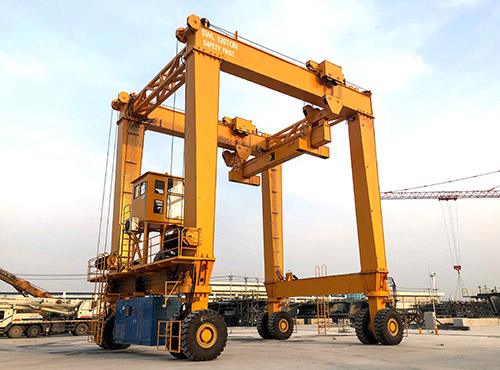
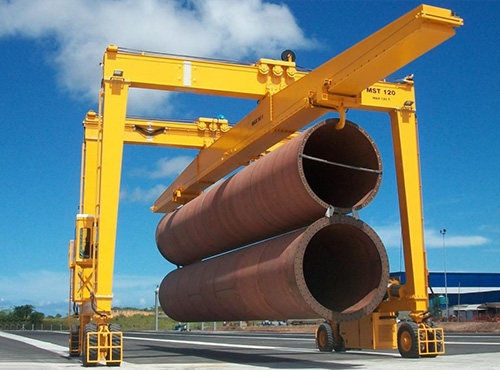
The straddle carrier is a kind of machinery that utilizes the intermediate space to carry and handle containers. Its typical structure includes two sets of tall legs, and the inner side of the legs is equipped with lifting devices (spreaders), which can directly grab, lift and move containers or goods. Differing from traditional forklifts or cranes, the design core of straddle carriers lies in “self-carrying movement” – without the need to use external loading and unloading equipment, you can independently complete the loading and unloading, transportation and stacking of goods, forming a “one-stop “Logistics solution.
The core value of straddle carrier is to realize the seamless connection of “loading and unloading + transportation”. Through the lifting device to accurately grab the container, without relying on cranes or forklifts to assist, you can directly lift the goods to a certain height above the ground (usually 0.5-1.5 meters), and short-distance transportation at a speed of 5-15 km / h. This feature significantly reduces the need for the traditional logistics of the container to be loaded and unloaded. This feature significantly reduces the time loss of “multiple loading and unloading” in traditional logistics, which is especially suitable for high-frequency cargo turnover in port terminals.
Ports and container terminals: build efficient transportation bridges between ships and yards, and between yards and trailers, realizing the rapid conversion of “ship – yard – car” and shortening the docking time of ships;
Industrial logistics centers: connecting production lines and warehousing areas within factories, completing cross-regional transfer of raw materials or finished product containers, and improving the efficiency of in-plant logistics;
Shipyards and heavy equipment sites: handling of heavy parts (such as hull segments, large machinery), its stable load-bearing structure can ensure the safe movement of heavy loads;
Temporary storage and construction sites: temporary stacking and shifting of containers in sites with limited space, adapting to complex terrain.
Equipped with high-precision hydraulic control system, the straddle carrier can realize millimeter-level position adjustment to ensure precise alignment when stacking containers. Its minimum channel width is only 1.6-1.8 meters (depending on the model), and with the in-situ steering function, it can operate in narrow areas (such as warehouse aisles and wharf corners) that are inaccessible to traditional cranes. In addition, through rational planning of stacking sequence, the space utilization rate of container yard can be increased by 20%-30%, which is especially suitable for areas with tight land resources.
As the core equipment for container and heavy cargo handling, the types of straddle carriers need to be analyzed in terms of technical characteristics, application scenarios, power systems, operation modes and other dimensions. Different application scenarios, as well as different budgets will affect the choice of straddle carrier type.
This type of straddle carrie adopts diesel engine as the power source, and transmits power to wheels through gearbox and drive axle, which is suitable for transportation of large goods.
Applicable scenes: This is mainly used in large logistics parks, heavy industrial sites and other scenes that require long-time continuous operation and relatively loose emission requirements. Diesel power has a strong range and does not require frequent charging, which is suitable for remote areas or places with imperfect power facilities.
Advantages and disadvantages of diesel straddle carrie:
Advantages: strong power, adapting to complex terrain and heavy load demand; convenient refueling, good continuity of operation; mature technology, low maintenance costs.
Disadvantages: high emission pollution, not in line with the stringent environmental standards; running noise, a certain impact on the operating environment; fuel cost fluctuations with oil prices, long-term use of higher costs.
Battery-driven:
Technical features: lead-acid batteries are used to store electric energy, and the wheels are driven by motors, with a power range of 100-300kW, a range of 4-6 hours, and support for quick battery replacement or charging.
Application: suitable for indoor warehouses, ports or industrial parks with high environmental protection requirements, and scenarios with small operation radius and complete charging facilities.
Advantages and disadvantages:
Advantage: zero emission, low noise, in line with environmental policies; low operating costs (electricity prices lower than fuel), simple maintenance (no engine maintenance).
Disadvantages: large weight of the battery, affecting the payload; shorter range, frequent charging or replacement of batteries; performance degradation is obvious in the low-temperature environment.
Lithium-ion battery drive:
Technical characteristics: using lithium-ion batteries as the energy carrier, energy density than lead-acid batteries to enhance 30% -50%, range up to 8-10 hours, support for fast-charging technology (1 hour charging 80%).
Application: scenarios with very high requirements for range, efficiency and environmental protection, such as automated ports, intelligent logistics centers, or places requiring long-distance and high-frequency operations.
Advantages and disadvantages:
Advantages: lightweight design, improving load capacity; long life (over 3000 cycles of charging and discharging), lower overall cost; support for energy recovery technology, improving energy utilization.
Disadvantages: high initial investment cost; complex battery management system (BMS), maintenance requires specialized technology; risk of overheating, need to be equipped with temperature control system.
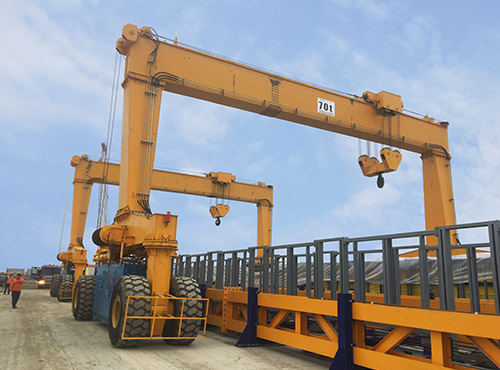

Although the initial investment of straddle carrier is higher than that of ordinary forklift trucks (the unit price is usually in the range of 500-1.5 million RMB), the integrated operation mode of the whole process significantly reduces the cost of labor, equipment coordination and time. For example, in a port scenario, a crane (1 operator), forklift (1 operator) and trailer (1 driver) are required to complete a loading and unloading operation in the traditional mode, whereas a straddle carrier requires only 1 operator to complete the operation independently, which reduces the handling time of a single container by more than 40%. In addition, the mainstream model adopts modular design, the key components (such as hydraulic pumps, tires) are highly versatile, low maintenance costs, and the average service life can reach 10-15 years, so the comprehensive return on investment (ROI) is better than similar equipment.
Lightweight design and terrain adaptation: the unladen weight is usually 15-25 tons, with puncture-resistant and wear-resistant tires (e.g., solid tires or pneumatic tires), straddle carrier can drive stably on gravel roads, dirt roads and other rugged terrain, the ground pressure is only 0.8-1.2MPa, much lower than the traditional cranes of 2-3MPa, to reduce the damage to the road surface. At the same time, the minimum turning radius of straddle carrier can be controlled at 3-5 meters, and even realize in-situ 360-degree rotation, to meet the needs of extreme space operations such as between shelves and container seams in the warehouse.
Structural stability: low center of gravity design (center of gravity height is usually less than 1.2 meters). Operational safety: the cab is divided into ground-type and overhead type, ground-type cab to reduce the risk of operators falling, and equipped with panoramic camera, ultrasonic radar and other auxiliary systems, to achieve a 360 ° dead-angle vision; overhead cab provides a wider operating perspective, standard with shock-absorbing seats and ergonomic operating table, to reduce fatigue driving.
As a technology-intensive equipment, the R&D and manufacturing cost of straddle carrier is significantly higher than that of ordinary forklift, resulting in higher market price. For small and medium-sized logistics enterprises, one-time purchase may cause cash flow pressure.
Long-term loading of 60-ton heavy loads (including equipment weight) may lead to wear and tear of the suspension system, tires and hydraulic parts, requiring regular stress tests (recommended every 500 hours). The lateral support structure of some models is weak and may deform slightly under extreme working conditions (e.g., rapid acceleration, sharp turns), which does not affect safety but needs to be calibrated in time. For high-frequency and heavy-duty operation, it is recommended to choose a model with a reinforced frame.
This needs to be considered in advance the standard load to be transported cargo, overload, and the value of the lifting height. For example, according to the main type of container to be transported (20-foot dry container, 40-foot reefer container, etc.), confirm the rated load of the equipment (usually 25-60 tons). For example, if you are handling a 40-foot reefer container (self-weight of about 4 tons, maximum load of 28 tons), you need to select a model with a rated load of ≥ 32 tons.
Before purchasing a straddle carrier, users need to analyze the conditions of the application site, including aisle width, floor loading, and space constraints. Measure the minimum aisle width of the working area to ensure that the equipment can pass through smoothly. If there are low-level obstacles (such as warehouse beams, factory cables), you need to confirm the total height of the equipment when it is lifted to the highest (usually 4-5 meters) to avoid collision.
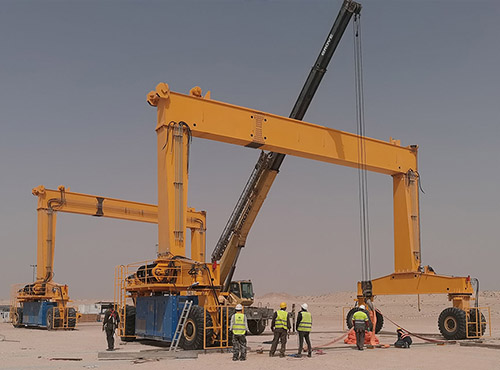
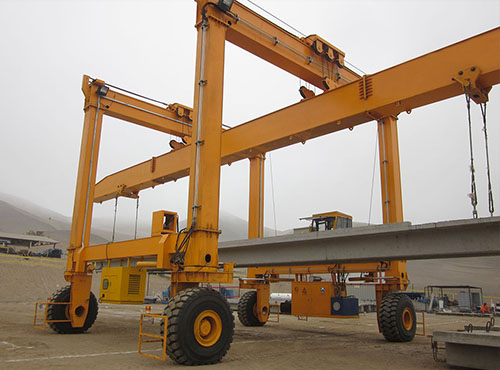
Yes, it can. The normal model of straddle carrier supports a minimum aisle width of 1.6-1.8 meters and is equipped with multi-directional steering function, which allows it to move flexibly in narrow areas such as between warehouse shelves and container yard aisles. When choosing, you need to confirm the “minimum turning radius” and “body width” of the equipment, and ask the supplier to provide field simulation tests.
This depends on the battery configuration and operating intensity. Conventional lithium battery models (300-500kWh capacity) can support 8-10 hours of operation under medium load, and models equipped with fast charging technology can replenish power during lunch breaks. For 24-hour continuous operation, it is recommended to equip backup batteries or choose “hybrid” transition models.
This requires comprehensive consideration of factors such as equipment purchase price, energy consumption, maintenance, labor, and downtime loss. For scenarios with high average daily operation volume (≥50 cases), although the initial investment of electric model is high, the TCO (total cost of ownership) within 5 years is lower than that of diesel model by about 15%-20%.
In conclusion, through the accurate selection of straddle carrier and scientific operation, enterprises can significantly improve efficiency, reduce costs, enhance safety, and take the lead in the global supply chain competition.